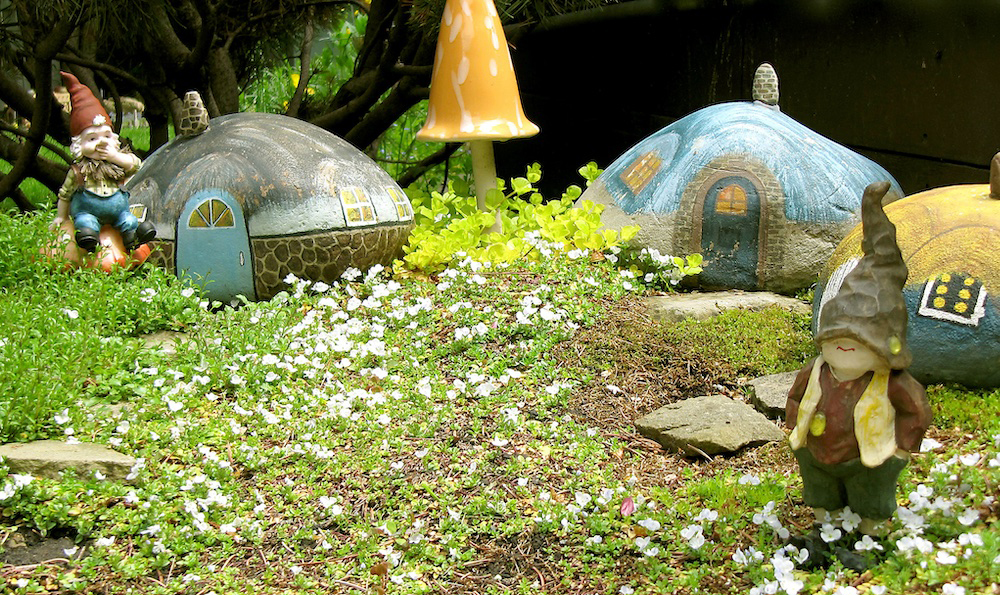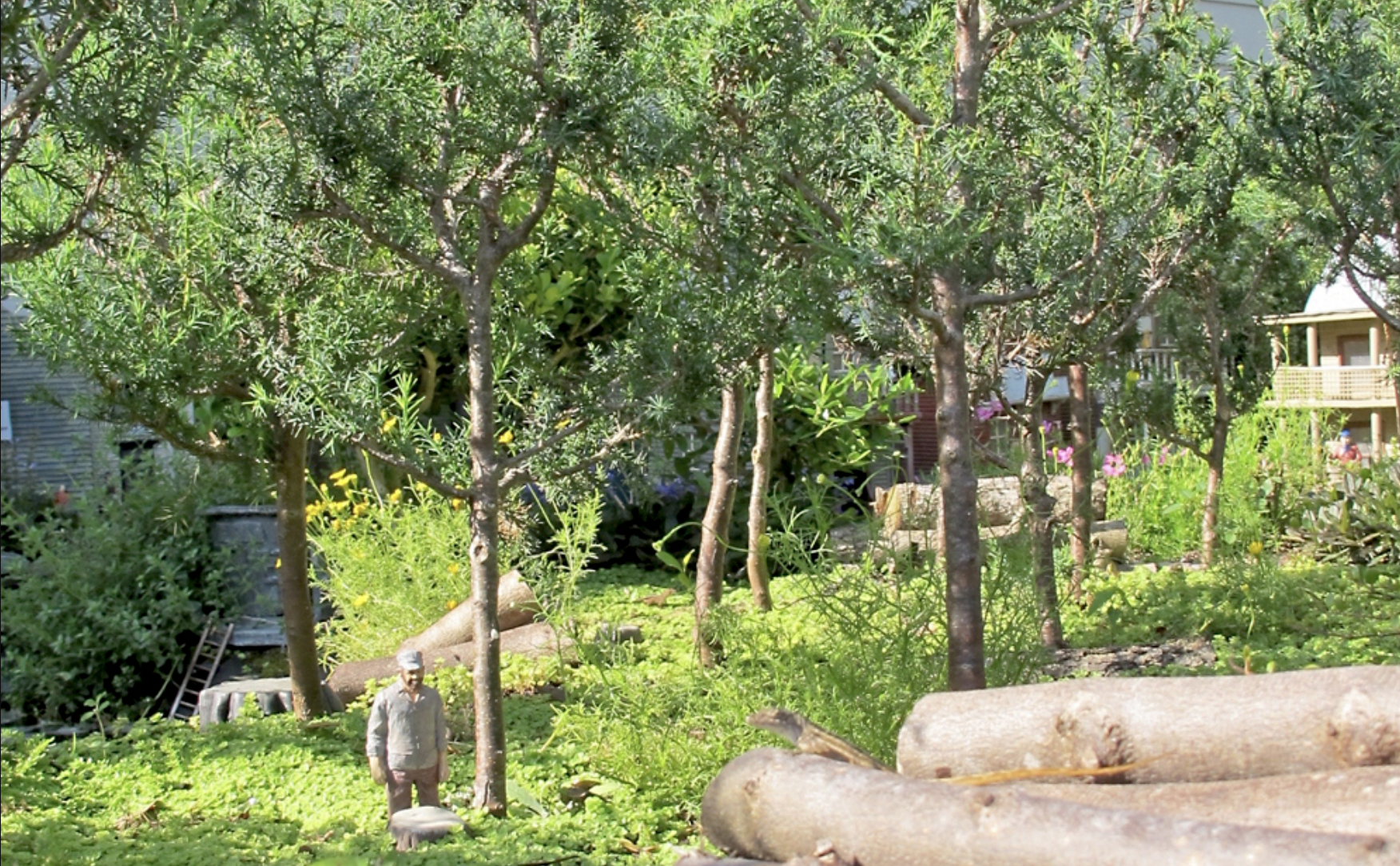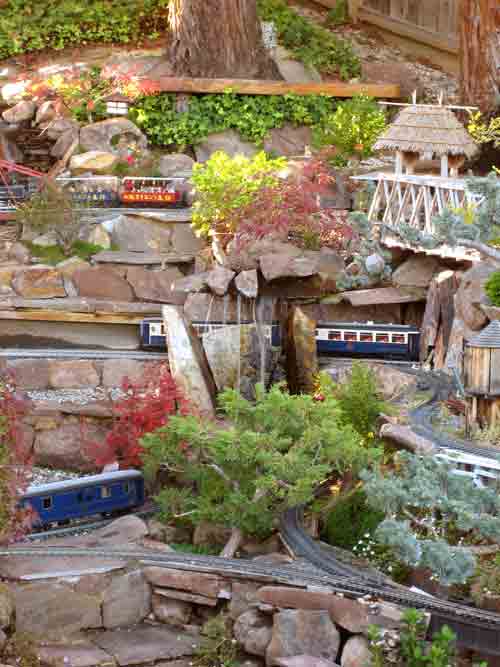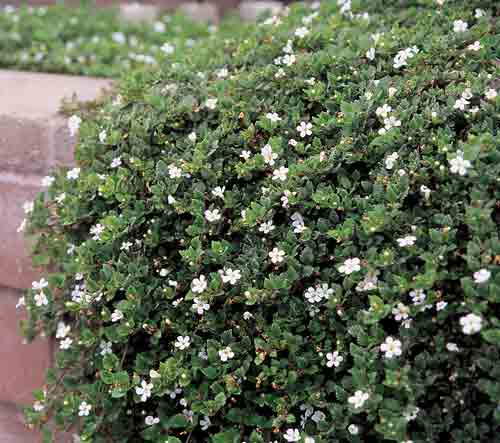What do your buildings have to say for themselves? Each structure evokes a feeling for its purpose, the folks who might live or work there, and a bit about the history that transpired on the premises, as shown in photo 1. How the structure was built and maintained is “written on the walls.” All of the buildings shown here are good examples of how the surrounding landscape can impart realism. The hardscape and plants show off each structure while blending it into the whole scene. Let’s get to the bottom of this subject.
The bottom
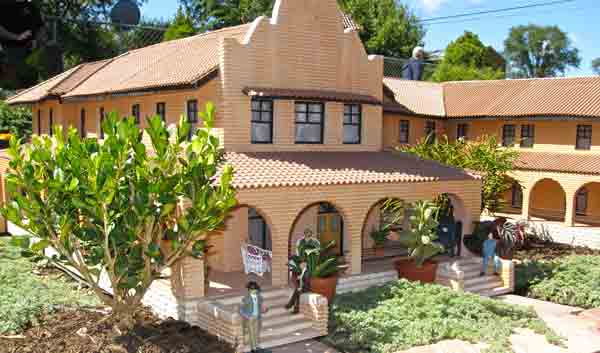
Begin with the base/footing/foundation. A good foundation will accomplish several goals, including stability from erosion, weed abatement, leveling of the structure, and a reserved spot on which to return the building after maintenance or storage.
For strong, level foundations, excavate 3-6″ beneath the extended footprint of each intended building location. For a level town row, dig one, large, flat-bottomed pit. Fill the void with an underlayment of several inches of crushed base rock or decomposed granite (DG). Tamp it with a tamper or walk on it. When the compressed material approaches the finish grade, top off the footing with DG fines or coarse sand.
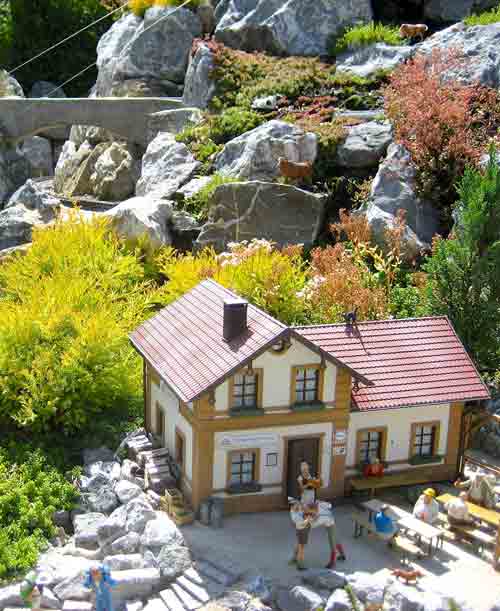
Now get on your knees and drag a level over the area, checking the bubble often and pushing the gravel where needed to level the ground. Tamp again and recheck the level. The surrounding earth may have to be retained with little walls of your choice if you’re working on a slope. Behind the structure, on the same slope, rock walls and wooden cribbing could retain a hillside, but the front may require more sophisticated detailing (see below).
If you’re sure about the placement and size of your building, you can mix cement products into DG or sand before completing the above process. In photo 2, the restaurant’s concrete foundation extends to include a patio; note how the mortared stone wall matches the surrounding stonescape, from which the wall’s stones would naturally have been gleaned. For a less permanent foundation, sprinkle or pour a 1:2 or 1:3 solution of concrete-bonding adhesive in water over the finish grade of gravel to set up the top inch or so.
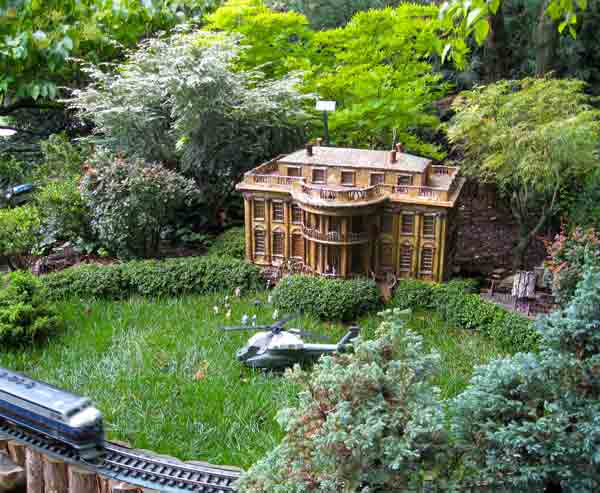
At this point you could augment the footing with a more solid base or foundation. HardieBacker cement board is a good choice for a hard foundation, provided care is taken not to breathe the silica dust while cutting it. DG fines may be glued to the board with Titebond II or III (or concrete-bonding adhesive) for a gravel-pathway or driveway look.
Whether you use tile, pavers or bricks, your strategy depends on your climate and your need to protect structures from pets and other hazards. Any hardened foundation makes blowing, hosing/washing and general cleanup far easier than dirt alone.
Curb appeal
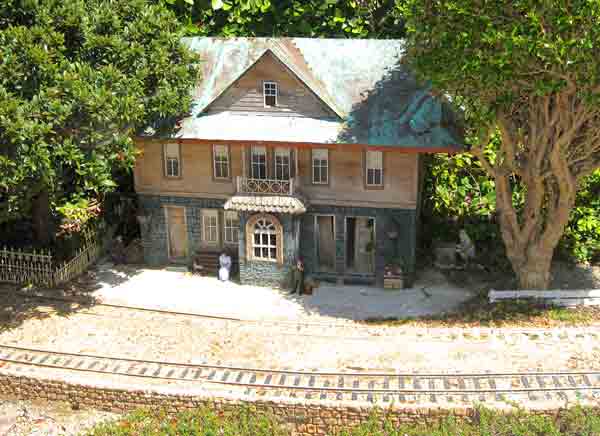
Urban or rural, the difference between full-scale (1:1) landscaping and miniature landscaping is in the number of plants required to create the desired effect. The principles remain the same, so we can look to the landscape pros for advice on how to “sell” a building. First, prepare the house by cleaning and repairing it. Remove all clutter: i.e., excess items that take away from the whole. Improve the lighting and visibility by adding or taking away shadows/foliage to change the mood. Finally, arrange all items to support the focal point of the building.
Photo 3 epitomizes a lush, modern landscape. The Chicago Botanic Garden arranges appropriately sized trees and shrubs to show off our president’s grand home. Note that larger trees behind the house keep the focus in front of it. The helicopter parked on the bonsai turf helps to tell the story of the White House.
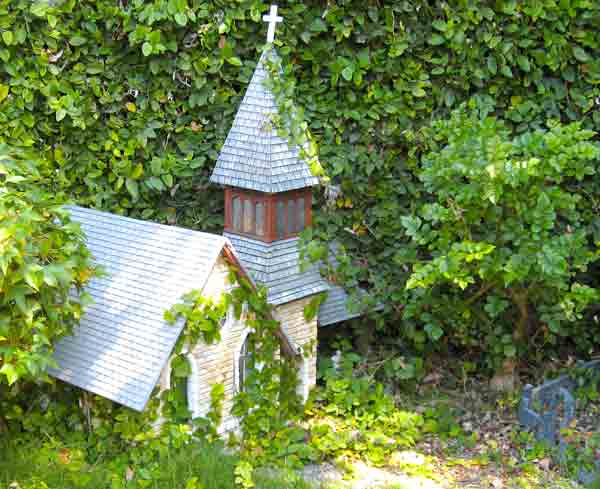
A century ago, landscaping with shrubbery from nurseries was uncommon. After constructing wonderful masonry foundations, as in photo 4, homeowners wouldn’t think of hiding their structures. Tom and Laura Rey model a 1917 Central California town, with scratchbuilt Precision-board (precisionboard.com) buildings. These rest on HardieBacker cement-board bases, retained by precision-board “stone” walls (see Tom Rey’s how-to in the Aug. 2007 GR). Conversely, when the Reys’ vine-covered fence got out of control in photo 5, the creeping-fig vines clung to a “stone” church to mimic a page out of Sleeping Beauty. This scene is a clue to the abandoned historic town it models, Kaweah, in the Sierra foothills, a utopian colony that didn’t quite make it (read the Reys’ railroad story in the Oct. 2006 GR).
Depth charge
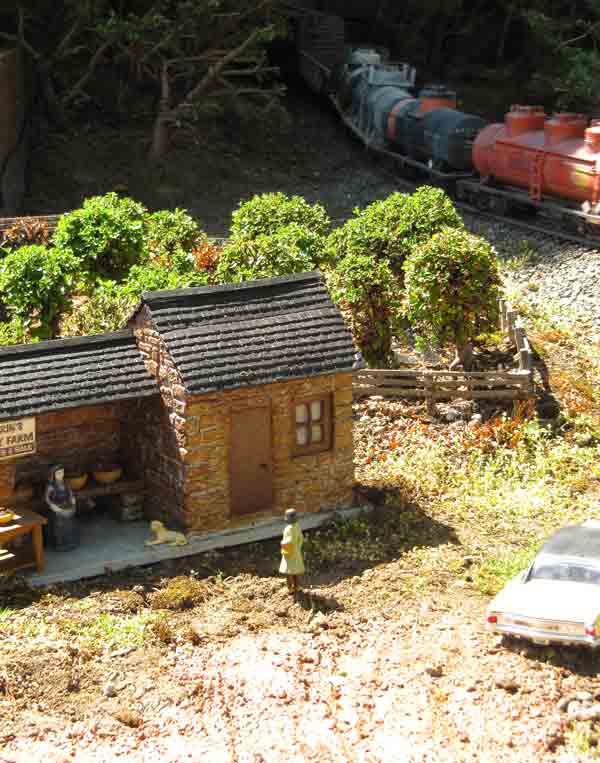
If you have a deep enough yard, you can layer natural or man-made elements both in front of and behind the buildings, similar to the way Walt Disney introduced us to multi-dimension cartoons. One of Walt’s multi-plane cameras is on display at the Disney family museum, including a video describing its revolutionary use in animation (www.youtube.com/watch?v=kN-eCBAOw60).
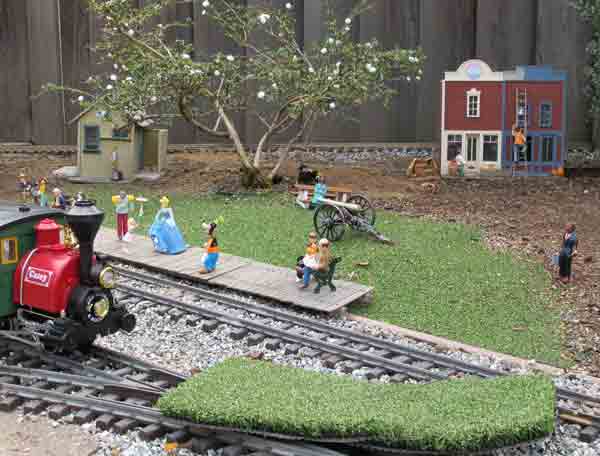
Our outdoor dioramas are like a cross between animation and full-scale landscaping. The most absorbing scenes suck us into the story to participate. By now we all know that planting larger leaves in front and smaller leaves in the rear creates the illusion of depth. Bluish shrubs in the rear become the hazy hills and up-front white or red buildings pop into view (photo 8). The Watters used another trick and lined up their town away from us instead of left to right, as is the usual. In photo 9, can you feel their Sierra whistlestop inviting us in, as if anticipating our arrival? One might have taken this photo while riding the train half a century ago. If a two-dimensional picture is worth a thousand words, a model is worth a thousand pictures.
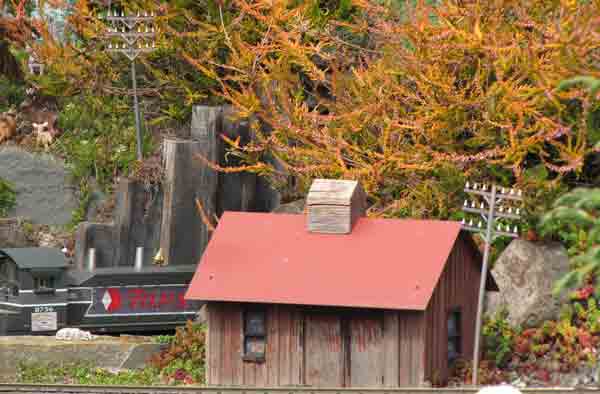
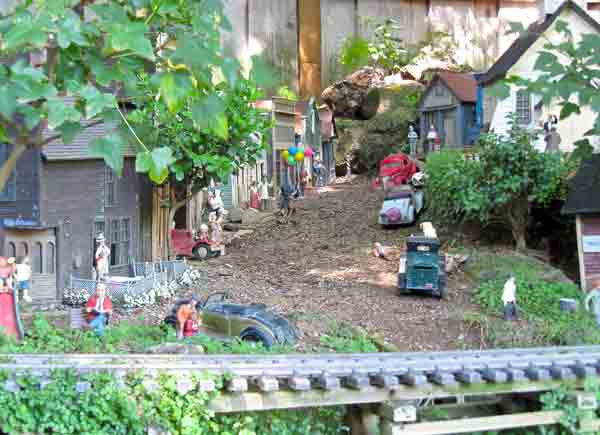
Don Watters constructs and maintains buildings and Sue Watters arranges the Truckee town folk on their shaded Lake Tahoe and Truckee Railroad in Zone 9. In the foreground, trident maples (Acer buergerianum, Zones 4-9) and a trestle infused with baby tears (Soleiolia soleirolii, Zones 9-11) contrast the dwarf boxwood (Buxus microphylla var., Zones 5-9) in the mid-ground and mountainous rocks behind the scene. Nancy Norris photo
Regional gardening reports
Zones listed are USDA Hardiness Zones
Question: How do you blend your buildings into the surrounding railway with a minimum of maintenance?
Keith Yundt
Victoria, British Columbia,
Canada, Zone 6b
Station-ary stone
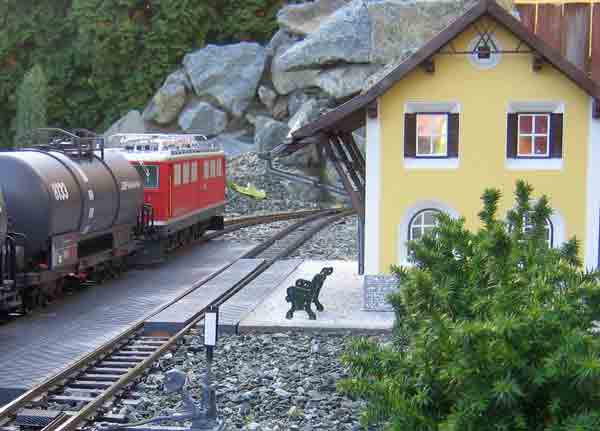
We agreed early on that we wanted a minimum of structures on our garden railway so that the railroad would retain a rural look that would fit well with our Swiss RhB (Rhätische Bahn) theme. To help retain the rural look, my first wooden structures were designed to sit on the ground—either on stone dust or low plants, such as sedums or Elfin thyme. For our two Pola-kit structures (a chalet inn and Susch Station), we decided to use store-bought, concrete stepping stones because they almost perfectly matched the footprint of the large inn and fit in well with the station and adjacent track platforms. The concrete keeps the plants (mainly moss) from encroaching, looks like a typical concrete-platform surface, and instantly levels the buildings when we put them in the garden.
Richard Friedman
Sacramento, California, Zone 9
Yard trees
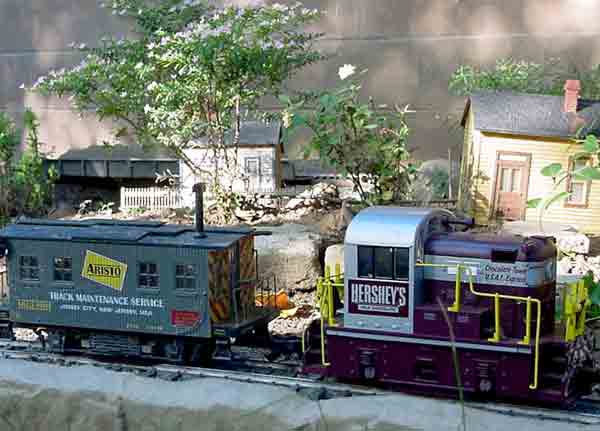
For trees that don’t hide buildings, I’ve got a couple of successes. I’ve found that false Mexican heather (Cuphea hyssopifolia, Zones 8-11) grows a little taller than many buildings. Clumping stems have a fairly loose structure, so they make a nice “yard” tree. The others that work well are micro-miniature roses (Rosa sp.). I’ve used them for windbreaks as well as “eye breaks” to separate scenes, that would otherwise be too close together. Lastly, I’ve got a dwarf azalea that was grown quite tightly but also makes a fine yard tree and has grown very little.
Cecil Easterday
Near Columbus, Ohio, Zone 5
Landscape catalog

Landscaping the buildings to make them look real is my favorite part of gardening in the railroad. Special favorites are those dwarf versions of my larger garden plants. They always make me smile as I watch them change over the years.
Lawn. The small leaves and tight growth of miniature moneywort (Lysimachia japonica ‘Minutissima’, Zones 4-8) make a nice, open yard in front of houses. The tiny yellow flowers that appear in May and June look like a lawn full of dandelions.
Yard shrubs. The very small Astilbe ‘Perkeo’ (Zones 4-9), with 6-8″ lacy foliage, bears tiny spikes of pink blooms. A dwarf goatsbeard, Aruncus aethusifolius (Zones 4-8), grows ferny leaves near the lighthouse. Also, in the shaded town, miniature hostas tucked around the edge of buildings perk up the railway. My favorite is H. ‘Cat’s Eye’ (Zones 3-8) with 3″ gold-centered leaves. My favorite “shrub” is Buxus ‘Koreansis Nana’. This miniature boxwood is placed at the corner of a replica of the house I grew up in. Now 10 years in the railroad, it’s 3″ tall and a foot wide, after only one pruning last summer.
Yard trees. A gorgeous dwarf conifer grows near one of the residences, so perfectly shaped that I always look twice at it. It’s a Picea abies ‘Little Gem’ (Zones 3-8), a true dwarf Norway spruce, only 18″ tall at five years old. Near the church, a nice broadleaf tree, dwarf variegated andromeda (Pieris japonica ‘Little Heath’, Zones 4-8) sports new red growth in the spring, turning to cream and green in the summer. Another attractive shrub that works in the city or the country is the Berberis thunbergii ‘Bagatelle’ (Zones 4-8). It’s one of the dwarf barberries (easily pruned to 18″), with bright-red foliage that really sparks up the landscape.






